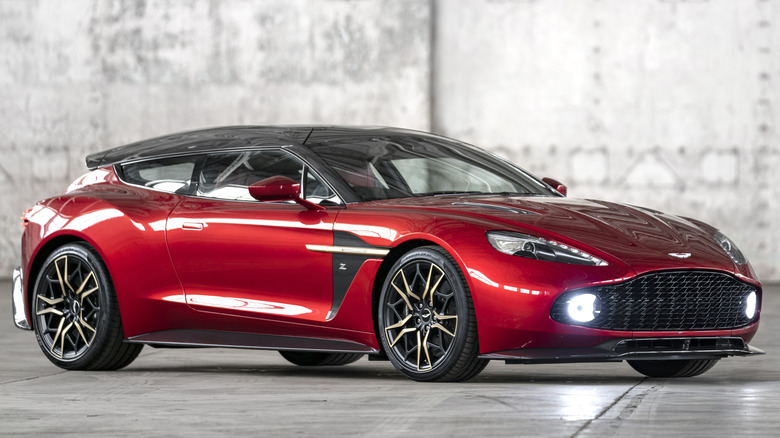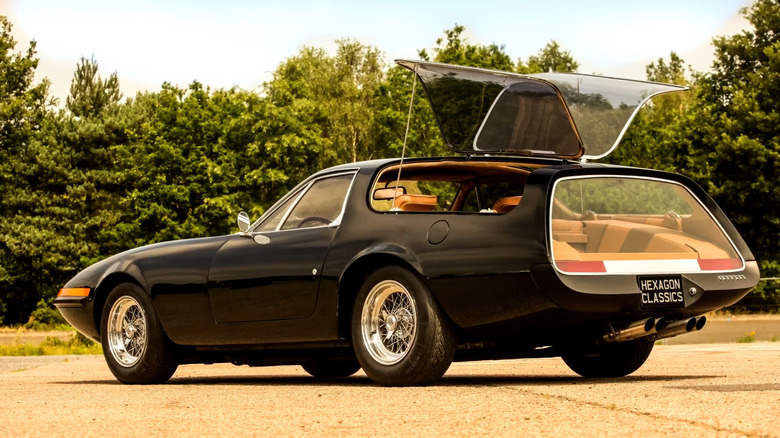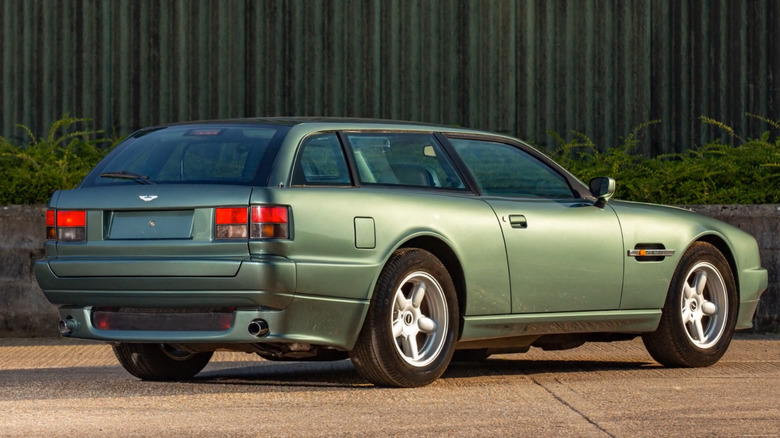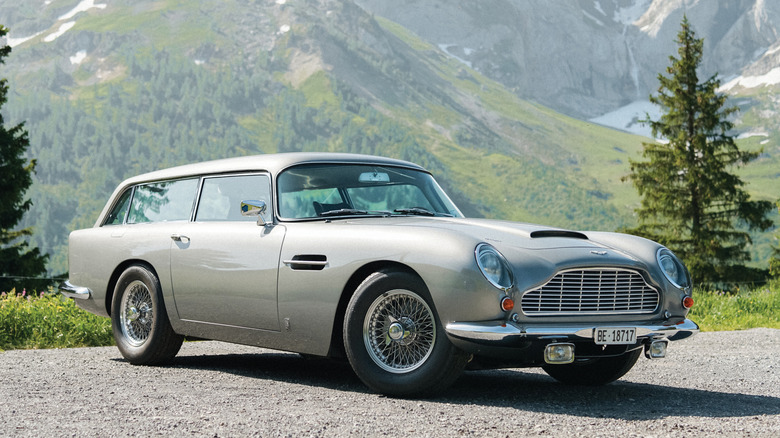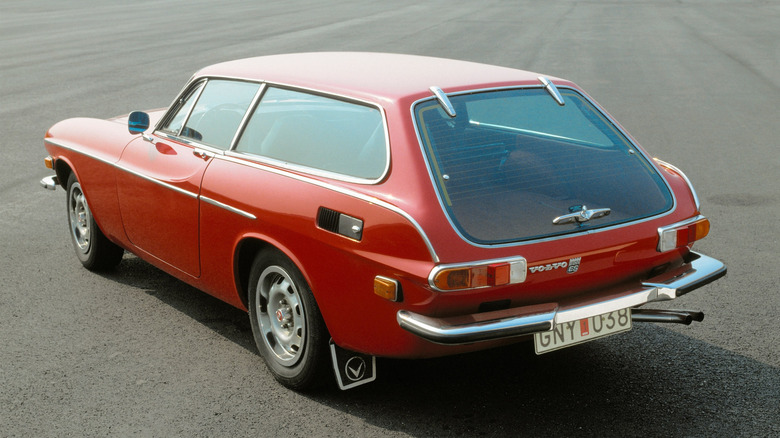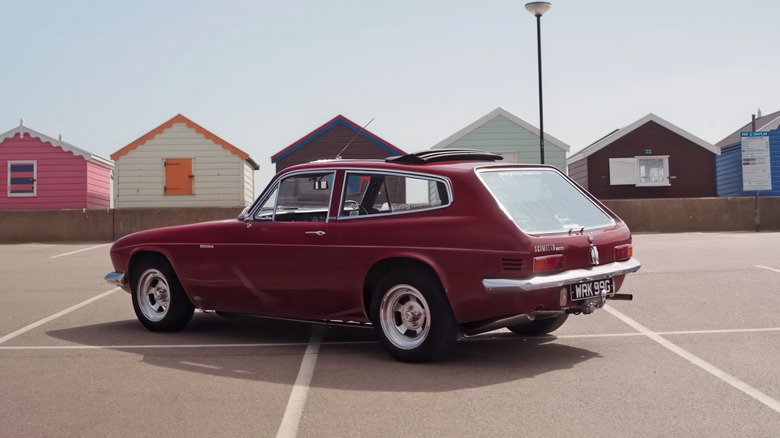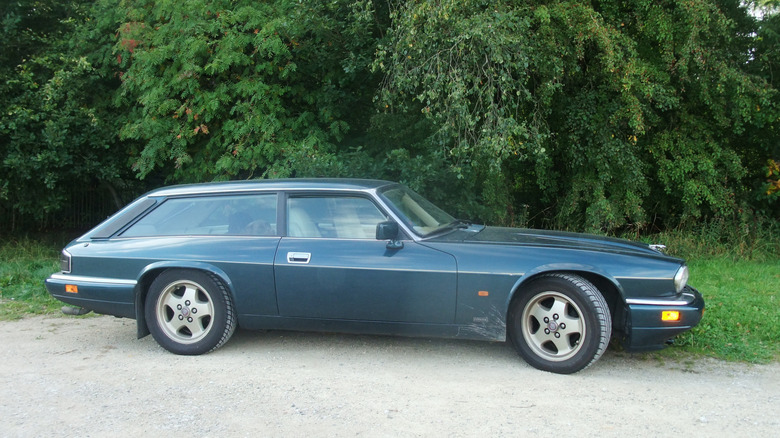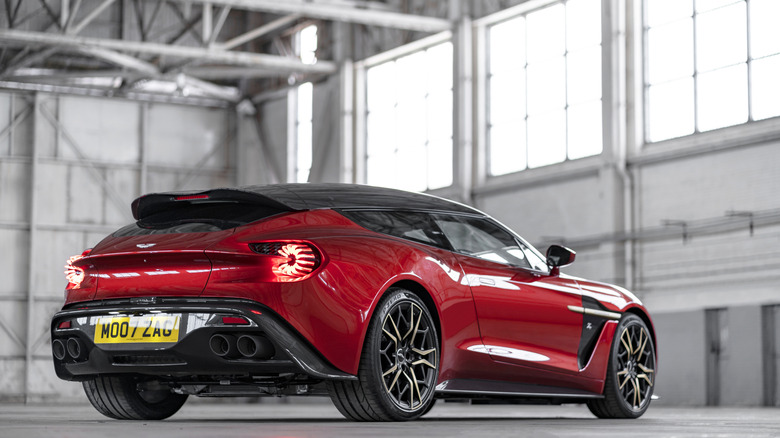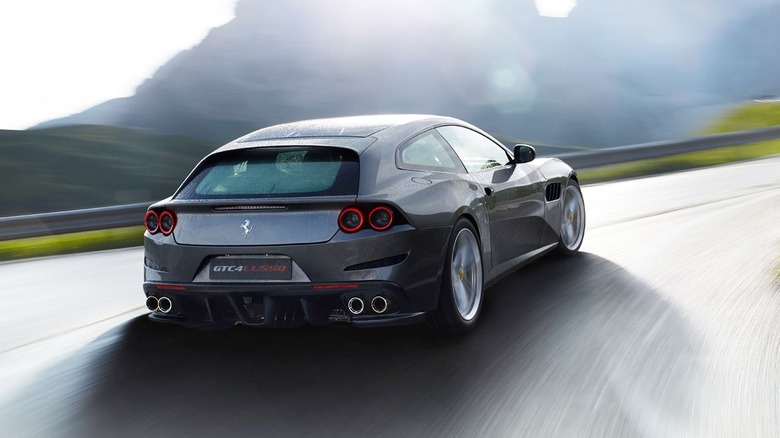8 Of The Best-Looking Shooting Brake Cars Ever Designed
No other body shape has captured the imagination of enthusiasts as much as the shooting brake. Before anything else, it's particularly rare, usually reserved for people with deep pockets. You're not likely to see a shooting brake version of the Toyota GR 86, though that didn't stop people from imagining such a cool car.
It's the idea behind shooting brakes that sets them apart from other cars. Based on sports coupes or GTs, shooting brakes offer all the advantages of these vehicles. Lightweight, with a weight distribution that edges out typical coupes or sedans, and exceptional performance, they have everything an enthusiast would want in a sports car.
Yet, thanks to the wagon-like rear end, shooting brakes are also more practical. Grand tourers were always deemed the best long-distance travel vehicles. They are fast on the highway. Confident on the twisties. Comfortable. Refined. A shooting brake adds additional luggage space to that equation, allowing you and your significant other to go on long trips without worrying whether the suitcases will fit. Oh, and without losing any of the trademark grand touring experience.
More than anything, though, shooting brakes are just cool. They retain that sleek coupe profile but add a more muscular rear end. It adds tension to the design, combining the dynamic front with a utilitarian rear. The longer, flowing roofline also emphasizes length and elegance while improving the stance. To celebrate this gorgeous and underrated body style, we'll give you the best-looking shooting brake cars ever designed with the original, two-door shooting brake shape. Let's dig in!
Ferrari 365 GTB/4 Daytona Shooting Brake
Few cars capture the shooting brake motif as well as the Ferrari 365 GTB/4 Daytona Shooting Brake. Just look at it! It's rock and roll meeting avant-garde design. Brash yet subtle and elegant, this stunning automotive sculpture ticks all the right design boxes.
Created by the coachbuilders at England-based Panther Westwinds, the 365 GTB/4 Daytona Shooting Brake has some of the bravest rear designs in automotive history. The elongated, sloping roofline is unmistakably wagon-like, but with unique details. There is no rear hatch opening, for example, as it was replaced by a big glass piece that also houses the taillights. Instead, Panther Westworks installed two gullwing-style glass doors on each side. Sure, this hampers practicality, but it looks damn cool. Meanwhile, the rising floor accentuates the dynamic profile of the Daytona, connecting perfectly to the front end.
The Daytona Shooting Brake retains all the good front-end bits of the Daytona. The long hood, pointy nose, and unique pop-up headlights scream speed and elegance. Under the nose, there is a huge grille hinting that a serious beast hides inside. Like the donor car, the Daytona Shooting Brake houses a 4.4-liter V12 that pumps out 352 hp, enough to bring the coupe to 62 mph in 6.1 seconds and a top speed of 174 mph. These figures aren't at all surprising, as the 365 GTB/4 was built to compete at the Daytona 24-hour race. Unfortunately, Panther Westwinds only built one example of this stunner, but that won't stop us from marveling at it from our small screens.
Aston Martin Virage Shooting Brake (1992 to 1999)
Next to the gracious styling of the Daytona Shooting Brake, the Virage Shooting Brake looks almost like a bully. There is no elegance here, just pure British muscle. Still, the Virage Shooting Brake perfectly unites the utilitarian wagon back end with Aston Martin's brawny looks at the time. The short overhangs make it kind of sleek in profile, which is of course reinforced with the wagon-like rear. The roof also doesn't slope in the rear, radiating powerful energy. The Virage Shooting Brake looks like a car that doesn't care what you think about it.
But the Virage Shooting Brake isn't just a bully on the outside. Under that long hood, it hides a 5.3-liter V8, good for 330 hp, paired to a five-speed manual. The shooting brake has a top speed of 152 mph, enough for the title of the fastest wagon at the time. But it also had other tricks up its sleeve, like a 50/50 folding rear bench and sizable fuel tank, making it a true long-distance brawler. Oh, and four times the space of the regular Virage! The regular, no-sloping roof paid off big time.
Unfortunately, the Virage Shooting Brake is a rare beast. Aston Martin has built only two examples from scratch, and six overall, some of which had four doors. Although super-rare, the Virage Shooting Brake isn't too expensive today. A few years ago, a perfect specimen sold for $126,500 at a Bonhams auction, making it a way more interesting buy than, say, a Supra Mk IV.
Aston Martin DB5 Shooting Brake (1964 to 1966)
Aston Martin was making shooting brake cars long before everyone else. In fact, perhaps its most popular model, the DB5, also got a more practical version. The Aston Martin DB5 was James Bond's companion in Goldfinger, which gave the car an almost legendary status in the automotive community. The swoopy, timeless styling certainly played a role there, and so did the 4.0-liter inline-six with 282 hp in standard form, or 325 hp in GT form.
For all its appreciation, DB5 Vantage's way rarer sibling, the DB5 Shooting Brake, has a much more interesting story. See, legendary Aston Martin owner David Brown needed a more practical car to carry all his hunting dogs and polo equipment. He asked Harold Radford, a coachbuilding firm, to create one. Obviously, the regular DB5 wasn't good enough for the job, so Aston Martin created a shooting brake version with a bigger and more easily accessible trunk.
Reworking the DB5 was no small feat, though. Aston Martin's engineers made significant modifications to the upper structure of the body, which required a lot of time and added plenty to the already exorbitant price. As a result, Aston Martin has only ever built 12 examples, though only one had the more powerful 4.0-liter engine.
No matter the engine, though, the DB5 Shooting Brake is a special vehicle. The designers managed to keep the essence of the DB5 intact, with the gently sloping roof accentuating the body's elegance. Still, the large rear and side windows uncover a more practical edge, which suits the graceful grand tourer exceptionally well.
Volvo 1800ES (1971 to 1973)
Volvo is a wagon brand as much as a Swedish brand. From the 850 T5-R, one of the best cars ever built with an inline-five engine, to the luxurious V90, Volvo has perfected the wagon formula. Yet the prodigy that started the lineage was the 1800ES — a shooting brake/wagon with a timeless look that still captivates to this day.
Like any good shooting brake, the 1800ES was based on a coupe in the P1800, which was already a stunner with its long hood, elegant profile, and sporty rear end. Yet the 1800ES is visually even more striking. Volvo's designers kept the sleek profile of the original, with the nicely integrated lines that added grace to the design.
Thanks to the glass hatch, the rear end appears more utilitarian but still visually interesting. The window sits lower than you'd usually find in hatchbacks or wagons, similar to the Daytona Shooting Brake, creating a unique rear end. The 1800ES also has unusually long windows on the sides, which make the car appear longer and sleeker. Yes, this means you won't hide anything in the trunk, but the large glass area turns the 1800ES into an art piece.
Up front, the headlights are masterfully connected to elevations on the hood. Between them, the large, almost gaping grille reveals the sporty pretensions of this shooting brake. The 1800ES isn't very powerful by today's standards, but its larger, 130-hp 2.0-liter engine was still good enough for a top speed of 115 mph. More importantly, the 1800ES was equipped with an electric overdrive function to fuel its grand-touring ambitions.
Reliant Scimitar GTE (1968 to 1986)
The Reliant Motor Company is mostly known in the automotive community thanks to the Robin three-wheeler, one of the weirdest cars ever made. It was a car only a mother could love, with iffy driving dynamics and foolish looks. So, you could only imagine how everyone reacted when they saw the Scimitar GTE Shooting Brake.
A departure from the brand's other offerings, the Scimitar GTE contains everything that's good about shooting brakes. Based on the brand's Scimitar GT coupe, it has a sporty tone to it, with a long, sloping hood and four slightly angry-looking circular headlights. Yet, it's the side profile that turns the Scimitar GTE into one of the best-looking shooting brake cars ever designed. The simple body surfaces and rising window line create a timeless look, with enough dynamics to accentuate the car's performance credentials. The rear end has the usual glass hatch we all love about shooting brakes, but done more tastefully. Crucially, the Scimitar GTE is beautifully proportioned — nothing appears out of place.
The Scimitar GTE also scored highly in the practicality department. Instead of the two-door layout of the coupe, this was a true four-seater. It had a spacious trunk, too. The two rear seats could fold individually for even higher practicality. For the time, the Scimitar GTE was also reasonably quick, utilizing Ford's six-cylinder engines. The most powerful 2.8-liter unit made 160 hp, tuned for long-distance cruising thanks to the long gearing. Still, the lightweight tubular frame chassis and fiberglass panels ensured that acceleration is good, too.
Jaguar XJ-S Lynx Eventer (1983 to 1999)
Perhaps no other car in automotive history screams sleek as loudly as Lynx Eventer's Jaguar XJ-S. Lynx Motors, a coachbuilder and engineering company, used the shooting brake design here to its fullest potential, creating one of the most graceful vehicles that, well, truly graces planet Earth.
Lynx's coachbuilders clearly knew what they were doing, as the rear end connects perfectly to the sleek, elegant lines of the XJ-S grand tourer. Visually, everything on this masterpiece is lean and delightfully stretched: the hood, the side profile, the side windows, even the rear overhang. Even though it appears long, because it's squished, it doesn't create any tension. Still, the rear haunches and taillights, a hallmark of the XJ-S coupe, give it a muscular appearance.
The XJ-S Lynx Eventer hides a potent V12 under the bonnet. The 5.3-liter unit made 295 hp connected to a three-speed automatic transmission. That combo was enough for a top speed of 155 mph. Lynx Motors also upgraded the rear suspension to cope with the added weight on the rear axle and keep driving dynamics intact.
Practicality was greatly improved, too. Lynx Motors moved the rear seats back to add rear legroom. Meanwhile, the trunk was also longer, and putting larger items inside was made easier thanks to the large rear liftgate. Showcasing attention to detail, the coachbuilders equipped the larger rear window with a wiper and washer. Considering all that work and high conversion price, it's not too surprising that Lynx Motors only built 67 Eventers.
Aston Martin Vanquish Zagato Shooting Brake (2019)
Aston Martin's latest shooting brake model was created by legendary Italian coachbuilding company Zagato, and, well, just look at it! Perfectly proportioned, with just the right lines and creases in the right areas, the Vanquish Zagato Shooting Brake is truly a sight to behold. Zagato has built upon the exquisite styling of the Vanquish, making it even more attractive. Those swooping lines and big haunches ooze hotness, with the aggressive sloping roof, small rear window, and striking taillights giving it a bold character.
The best part about this stunner is that it was built on the last-gen Vanquish grand tourer, which had none of the modern turbocharged nonsense. Under that long, sculpted bonnet, the Zagato Shooting Brake hides a naturally aspirated 5.9-liter V12. Why is that important? Well, it sounds like a dream. Angry, yet mechanical and refined. With 592 hp on tap and a relatively quick ZF eight-speed auto, it's also no slouch, bringing the Vanquish Zagato Shooting Brake to 62 mph in 3.5 seconds and a top speed of 200 mph.
Still, Zagato wasn't only concerned about style and performance — practicality was also important when creating the Vanquish Shooting Brake. So, the coachbuilders opted for the rear-end structure from the Rapide sedan, which was designed to accommodate a low-slung fuel tank. The wheelbase grew, too. As a result, the shooting brake has a long, flat load area. Unfortunately, the Vanquish Zagato Shooting Brake is strictly a two-seater, but at least it's a practical one.
Ferrari GTC4Lusso (2016 to 2020)
Most automakers rework original GT cars to create shooting brakes. Not Ferrari, though. In 2011, the Prancing Horse launched the Ferrari FF — a standalone grand-touring four-seater with a shooting brake rear end. The FF had Ferrari's hallmark V12, but also a unique 4RM AWD system with a separate Power Transfer Unit that sent power to the front, and the usual transaxle sending power to the rear wheels.
The FF was already a stylish shooting brake car, but its successor, the GTC4Lusso, brought the practical Ferrari formula to new heights. It added a dose of aggression to the swoopy styling, with more creases across the body and a keener front end. At the rear, the GTC4Lusso boasted four taillights and four exhaust pipes, giving it a more muscular appearance. Yet, it all worked together in harmony — the GTC4Lusso has the perfect shooting brake proportions. It's elegant and gracious, yet sporty and dynamic-looking.
The same is true for GTC4Lusso's mechanics. The AWD system was upgraded to a 4RM unit with rear-wheel steering, E-Diff, and SCM-E suspension damping, allowing the driver to attack corners elegantly, even on wet and snowy roads. Yet, with a 6.3-liter naturally aspirated V12 that pumps out a staggering 680 hp, the GTC4Lusso can easily overcome the tire grip and turn into a playful machine. It scores a 0-62 mph time of 3.4 seconds and a top speed of 208 mph. It sounds amazing, too, almost like an old F1 car. A twin-turbo V8 with 602 hp was also available, though with a duller soundstage. Both will seat four adults in comfort, though.
